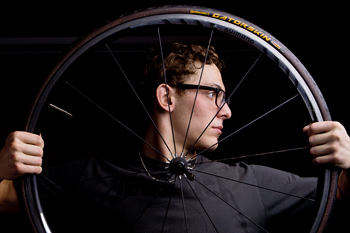Hello, Pratt Pool
By Ben Badua
Photos by Rob Mattson
The annual Escape from Alcatraz triathlon isn’t for the faint of heart. Drawing 2,000 of the world’s best triathletes every year, its extreme conditions test even the sport’s most seasoned veterans.

Just before 7:30 a.m. on June 20, 2012, Reeven Nathan ’16 waited at the San Francisco Bay for the starting gun to fire. He was antsy. How am I going to do this? Why did I pick this sport? Then he dove into 50-degree water.
The race opened with a 1.5-mile swim through the bay’s strong currents. Nathan was rusty as a swimmer, having returned only two weeks earlier from a yearlong stint in the Israeli army. Coming out of the swim in 29th place, he gained some ground in the triathlon’s second leg—an 18-mile bike ride through Golden Gate Park. Finally, he ran eight miles through the Golden Gate National Recreation Area, where the year he’d spent running in the hot desert sun paid off. Nathan finished in 26th place.
Escape from Alcatraz has never been Nathan’s best race, but it’s always his favorite. He’s participated in the event three times, improving each year. “It’s the hardest and the most fun,” he says. “It’s been my weakest race the last three years because it’s at the start of the [triathlon] season, so I’m usually just coming out of swimming [season] and have a week or so to get into running and biking shape.”
A first-year on the Amherst men’s swimming and diving team, Nathan does not often shy away from a challenge. He started running at age 13, when his mother bought him running shoes for his birthday. He picked up biking as a young teenager. He set out to master the last piece of the triathlon when he found out his father thought his little brother was the better swimmer. Nathan is now one of the top-ranked junior triathletes (ages 16 to 19) in the nation. That success hasn’t come easy—and if it had, where would the fun be in that?
Nathan starts his longest summer training days at 5:20 a.m. with a three-hour, 80-mile bike ride with a group of cycling enthusiasts 30 years his senior. Next, he begins the second leg of his “brick workout” (so called because that’s what his legs feel like afterward), a 10-mile run near his home in Highland Park, Ill. He wraps things up with a 45-minute, 3,000-yard recovery swim.
He participates in five to six races per season, which typically runs from late spring through early fall.

In 2011, at the end of high school, Nathan knew he wanted to take gap year before college. His options: join a professional bike team in Europe or the Israeli army (which he could join as a U.S. citizen).
“I can always do the biking,” he decided. “This was a once-in-a-lifetime chance.” He chose the army.
But before leaving the United States, he wanted to take care of unfinished business: the Chicago Triathlon. This race is one of few in which juniors can earn their “pro card”—a USA Triathlon license—by finishing within 8 percent of the winning professional’s time or in the top three of the elite amateur ranks. In 2010, Nathan had placed fourth.
The 2011 event took place on Aug. 28. That day, he woke at 3:30 a.m. and noted the high wind. In the water, he battled rough conditions that cost one swimmer a cap and another a pair of goggles; he exited the lake in fourth place.
On the bike, he pulled into the lead for an early two-mile stretch. After briefly giving way to another biker, he rallied, building a comfortable four-minute lead heading into the run. Nathan gave up some ground at the turn of the 10K run—his weakest event—but it didn’t matter in the end. He won the race by a little less than a minute, earning his pro card.
“I crossed the finish with the word shalom,” he says. “Shalom, finish line; shalom, USA; and shalom, Israel, here I come!”
After two months of basic training, Nathan was assigned to a base in northern Israel near the Lebanon border, where he served, appropriately, as a combat fitness trainer. He began each day leading soldiers in a five-to-10-mile run in full military gear. “People in Israel thought I was crazy for coming,” he says. “They didn’t get the motives. I just wanted that experience, and it was a way of helping Israel without living there.”
Today, Nathan has added an undergraduate course load to his obligations. By the end of the winter season at Amherst, he’d logged 60,000 yards a week in the pool as a freestyler on the swim team. And he planned to make his way to San Francisco in March to once again take part in the Escape from Alcatraz, hoping to beat his previous time in his favorite race.
Training Log
Each week during triathlon season, Nathan logs:

- 30–40 miles running
- 15,000–20,000 yards in the pool
Badua covers athletics for Amherst magazine. He is the college’s director of sports information.